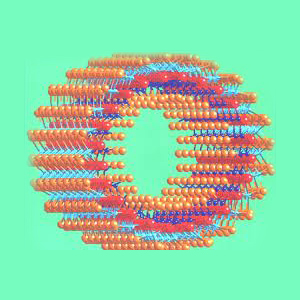Inorganic Nanotubes

Description
An inorganic nanotube is a cylindricalmolecule often composed of metaloxides, and morphologically similar to a carbon nanotube. Inorganic nanotubes have been observed to occur naturally in some mineral deposits .
Although Linus Pauling mentioned the possibility of curved layers in minerals as early as 1930, synthetic inorganic nanotubes did not appear until Reshef Tenne et al. reported the synthesis of nanotubes composed of tungsten disulfide in 1992.
In the intervening years, nanotubes have been synthesised of many other inorganic materials, such as vanadiumoxide and manganeseoxide, and are being researched for such applications as redoxcatalysts and cathode materials for batteries.
Inorganic nanotubes are heavier than carbon nanotubes and not as strong under tensile stress, but they are particularly strong under compression, leading to potential applications in impact resistant applications such as bullet proof vests.
Electrical conductivity -- probably the best conductor of electricity on a nanoscale level that can ever be possible
Thermal conductivity -- comparable to diamond along the tube axis
Mechanical -- probably the stiffest, strongest, and toughest fiber that can ever exist
Molecular perfection -- essentially free of defects
Self-assembly -- strong van der Waals attraction leads to spontaneous roping of many nanotubes. Important in certain applications
Synonyms
inorganic nanotubes, inorganic buckytubes, WS2, MoS2, NbS2, BN,
Chemical Properties
Inorganic nanotubes, WS2, MoS2, and NbS2
Typical Applications
Semiconductor devices, sensors, biosensors, and nano-motors, flat panel displays, atomic force microscopes, conductive plastics, & superconductors